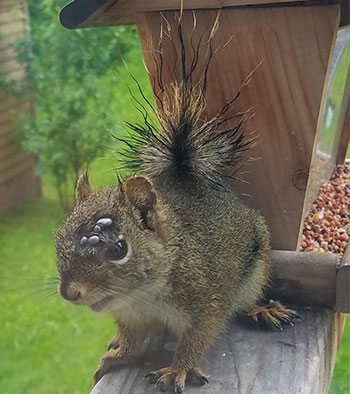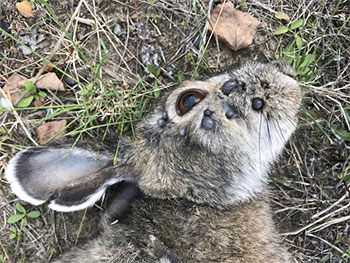Parasites and Diseases
Tularemia
Tularemia

A red squirrel with the common squirrel or vole tick, Ixodes angustus, which is the most common native tick in Alaska. Photo submitted to state veterinarian Dr. Bob Gerlach by Rebecca Standal.

The common hare or rabbit tick, Haemohysalis leporispalustris, which is found on rabbits and hares throughout North America, transmits the Tularemia bacteria between hares and can cause anemia. Photo submitted to ADF&G wildlife veterinarian Dr. K. Beckmen by M. L. Peters.
If you find disease or a parasite specimen that you feel should be submitted for examination, please follow the instructions on the form found here: Submitting Samples for Disease/Parasite Investigation (PDF 297 kB).
| What causes tularemia? |
- Tularemia is caused by a bacterium known as Francisella tularensis.
- There are two major cycles of this disease. The first occurs on land. Snowshoe hares are the primary host. The disease is spread from an infected hare to a susceptible hare by means of ticks. Ticks are only present on hares from May through September. The disease essentially disappears from October through April.
- The second cycle occurs in water. Beaver and muskrats are the primary hosts. Infected animals die in a slough, pond or lake. As the carcass decomposes, large numbers of bacteria are released into the water. Susceptible animals are exposed when they drink or swim in the water.
| Where does tularemia occur? |
- In Alaska, this disease is most common in the Interior.
| What are the signs of tularemia? |
- In the latter stages of disease, hares become very slow.
- Tularemia causes some internal organs (such as the spleen and liver) to become enlarged. Sometimes, white spots may also be seen on these organs.
| How can I protect myself? |
|
- People are susceptible to infection. Do not handle hares found dead or brought in by pets with your bare hands.
- Tularemia Fact Sheet for Pet Owners (PDF 42 kB)
- Contact of an infected pet's saliva or an infected hare's fluids into a cut, bite or abrasion on the skin may also allow disease transmission.
- Wear protective gloves when gutting hares, muskrats and beavers, especially during spring/summer/fall.
- Dogs and cats can die from tularemia. Infected hares are easy for dogs and cats to catch. Pets are infected when they eat the internal organs of infected hares. This disease is one reason why pets should not be allowed to roam free.
| Can I eat the meat? |
- Normal cooking temperatures kill bacteria in the meat. Therefore, it is safe to eat. However, human exposure typically occurs while gutting a hare.
| Samples to collect |
- You can submit an entire hare, muskrat or beaver carcass (or just the spleen and liver).
- To report an occurrence or to submit a sample for identification/analysis, contact the DWC Wildlife Disease Surveillance reporting hotline 907-328-8354, send an email to dfg.dwc.vet@alaska.gov or visit your local ADF&G office.
